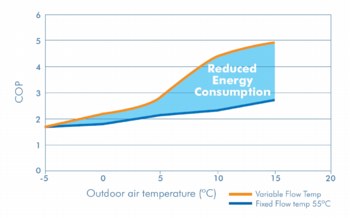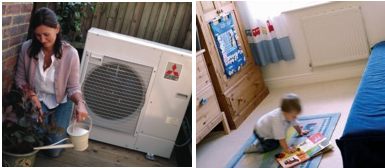Delivering renewable energy

Heat-pump technology is the key to the strategy devised by consultants Maleon to meet the renewable-energy requirements of this mixed-use project at 41 to 51 Bolsover Street in London’s West End. The heat pumps will provide both heating and cooling.
While not directly a source of renewable energy, heat-pump technology provides a very effective way of harnessing renewable energy — and can also help meet the renewable-energy requirements for planning permission.One of the difficulties in exploiting renewable energy sources such as solar and wind is their erratic nature. Neither of those sources of renewable energy is necessarily available when it might be most needed. Solar energy is not available when it is dark, and the wind speed can be too low, or too high, for wind turbines to operate. Electricity from solar photo-voltaics and wind turbines cannot be stored. In contrast, solar thermal can be stored as hot water, making it a more versatile form of renewable energy. Neatly overcoming the problem of the availability of renewable energy is heat-pump technology. Whatever source of renewable energy is used by heat pumps is always available — whether that source be air, the ground or water. While the quantity of heat delivered by a heat pump depends on the source temperature, useful energy is always available — even from air at night in the depth of winter. A heat pump with a COP (coefficient of performance) of three uses 1 kW of electricity to capture 2 kW of renewable energy — making the renewable-energy component 66% of the total output. With a COP of four, the renewable-energy component rises to 75%. In countries such as Norway with its preponderance of hydro-electricity, using heat pumps for space heating and hot water is essentially carbon neutral, and the main value of a heat pump is to make that hydro-electricity go further. In France, where nuclear electricity dominates, heat pumps again make better use of electricity. In Britain, with fossil fuels providing most of our electricity, the role of heat pumps is to reduce the direct usage of fossil fuels. Ground-source heat pumps achieve more stable COPs than air-source — because the ground temperature is more stable. In the depth of winter when the ground is warmer than the air, they deliver higher COPs. An additional benefit of reverse-cycle heat pumps linked to the ground is that heat can be rejected into the ground in the summer more effectively than into the air — reducing the energy needed for cooling and, at some times of the year, making possible free cooling.
Central London As a means of meeting the 10% renewable-energy requirement for a project in central London, consulting-engineering practice Maleon is exploiting the capabilities of ground-source heat pumps. 41 to 51 Bolsover Street in London’s West End is a mixed-use development of 18 000 m2 with four main user groups. They are the outpatients’ department of the Royal Orthopaedic Hospital, speculative office accommodation, private residential accommodation and affordable housing. There are a hundred accommodation units in all. Work is expected to begin on site early next year. James Cottee of Maleon explains that other types of renewable energy were considered, but none were satisfactory for this project. Solar photo-voltaics was rejected as having a very long payback. Wind turbines would have both too large and too noisy. And, at the time the project was being planned, biomass boilers using fuel such as wood chips was not considered to be practical for a site in central London, given the requirement for storing wood chips and transporting them around the site. As James Cottee reminds us, the first stage of meeting 10% of energy requirements using on-site renewable energy is to reduce that actual energy requirement — so that the 10% becomes smaller in absolute terms. He explains, ‘We worked closely with the architect to improve the fabric of the buildings and achieve a lower U-value than Building Regulations require. In addition the office lighting is provided by low-energy light sources which are controlled according to the available daylight.’ Further improvements in energy efficiency are achieved by installing centralised plant in the underground car park rather than distributed plant — which would be less efficient. The site is large, so there is ample space for a closed-loop system using boreholes. There will be 15 boreholes on each of the two phases of the project, with each heat pump served by four or five boreholes and providing both heating and cooling to the various buildings on the site. The planning authority is Westminster City Council, and James Cottee tells us that there were no special difficulties in obtaining planning permission for the boreholes — though the Environment Agency needs to be informed. To maximise the efficiency of the heat pumps for space heating, underfloor heating will be used, served by water at 45/35°C. Similarly, to maximise the efficiency of air conditioning, heat will be rejected to the ground, enabling a COP of about four to be achieved, compared with around three for an air-cooled condenser. The ground-source heat pumps can meet only a proportion of the site’s heating and cooling requirements and will be supplemented by conventional plant. However, a sophisticated controls system will ensure that the heat pumps operate as the lead plant to maximise the use of renewable energy.
Domestic project Heat-pump technology is also being applied to ‘domestic boilers’ by companies such as Mitsubishi Electric. The Ecodan heat-pump boiler gathers over 70% of the heat energy it needs from the surrounding air — making it significantly more efficient at providing heating and hot water than modern condensing gas boilers. To gain experience with the capabilities of the Ecodan heat-pump boiler, Mitsubishi has installed it in a house that dates from 2000. It has four bedrooms and was previously heated by an 80% efficient gas-fired boiler with an output of 23 kW. The total heat output of the radiators with a flow of 70°C is 13.4 kW, and the hot-water use is 140 l/day — so the boiler could be regarded as generously sized! An assessment of the heat loss of the house came up with 8 kW at –5°C ambient — indicating that a radiator temperature of 70°C was also generously high. Indeed, it was calculated that at a temperature of 55°C, the radiators would have a heat output of 8.4 kW, so they could be run at much lower temperature for most of the heating season. The Ecodan unit installed has an output of 8.5 kW when the air temperature is –5°C and can modulate down to 3 kW. It operates with a specially developed Gledhill Boilermate thermal-storage unit which controls the distribution of hot water to the heating circuits and the supply of domestic hot water. The Boilermate is connected to the outdoor heat pump, which requires only a single-phase power supply, by flow and return pipes. DHW is stored at 52°C, and the tank is heated by an immersion heater to 60°C once a week to avoid any risk of legionella. This installation is heavily instrumented to monitor its behaviour and performance. On a moderately cool day recently, with doors open to give more heating load, flow/ return temperature to the radiators was 44.1/39.7°C. Ambient temperature was 12.3°C. The heat emitted was 5.3 kW for a power consumption of 1.2 kW — achieving a COP of 4.4. Taking the decision to use heat-pump technology for space heating is only the beginning of reducing energy consumption and the emissions of carbon . Not only is the sizing of a heat pump vital to minimise the capital costs but the way it is operated is crucial to realising maximum efficiency. As Jason Tinsley, who is technical and product marketing manager for the heating department of Mitsubishi Electric, explains, one of the most important issues is to vary the flow temperature according to the temperature outdoors — what is known as weather compensation for wet heating systems. Mitsubishi Electric’s figures suggest that with a flow temperature of 55°C to the heat emitters in response to an outdoor air temperature of -5°C would result in a COP of 1.6. Reducing the flow temperature to 30°C with an outdoor temperature of 15°C would result in a COP of 5.0. The flow temperatures needed with outdoor temperatures of 5 to 10°C would give COPs of 4 to 4.5.
 |
If the principles of weather compensation are used to control the flow temperature from a heat pump serving a wet heating system, the COP improves enormously. |
In contrast, if the flow temperature were held constant at 55°C regardless of the outdoor temperature, the COP would improve only marginally from 1.6 with an air temperature of -5°C to 2.7 with an air temperature of 15°C (see graph alongside). Allowing the flow temperature to vary in response to outdoor temperature would result in a COP of 2.2 with an outdoor temperature of 0°C, rising slightly to 2.6 at 5°C. The COP would increase sharply to 4.4 for a further 5 K rise in outdoor temperature to 10°C and substantially again to 5.0 at 15°C. As Jason Tinsley reminds us, the reason we are exploiting heat-pump technology is to reduce carbon-dioxide emissions — and the increases in COP outlined above are all-important. If a heat pump were set up to deliver a fixed flow temperature of 55°C to a wet heating system its carbon-dioxide emissions, for a 150 m2 would be only 14% lower than with a gas-fired boiler operating at a fixed-flow temperature of 70°C. With a flow temperature of 45°C the reduction in carbon-dioxide emissions compared with the gas-fired boiler would be 42%. At the lower flow temperature of 35°C, such as with underfloor heating, carbon-dioxide emissions would be 45% lower than the gas-fired boiler.
 |
Underfloor heating for real — this Mitsubishi Electric Ecodan ‘heat-pump boiler’ uses radiators that were previously served by a gas-fired boiler of much higher output. At the heart of the system, in the airing cupboard, is a specially developed Gledhill Boilermate thermal-storage unit which controls the distribution of hot water to the heating circuits and stores domestic hot water. |
Controlling flow temperature also has a major effect on running costs. In this same 150 m2 house, a heat pump running with a fixed flow temperature of 55°C would cost only 5% less to run than a gas-fired boiler with a flow temperature of 70°C. Allowing the flow temperature to drop to 45°C when appropriate would increase the saving to 35% and to 39% if the flow temperature were allowed to drop to 35°C, for example with an underfloor heating system. Ecodan is specifically designed for the domestic market. It requires only a single-phase electricity supply and is housed in a single, compact unit that is said to be significantly smaller than previous air-source heat pumps. And to those who are sceptical about such air-source heat pumps, Jason Tinsley comments, ‘Over 250 000 heat-pump systems were installed in Europe in 2006, so this type of heating is already proven, and the advances made in this technology now offer huge potential to help the country reduce emissions.’
For more information on this story, click here:
Nov 07, 78Related links:
Related articles:











